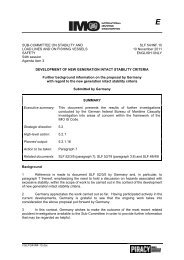Examination of the intact stability and the seakeeping behaviour
Examination of the intact stability and the seakeeping behaviour
Examination of the intact stability and the seakeeping behaviour
Create successful ePaper yourself
Turn your PDF publications into a flip-book with our unique Google optimized e-Paper software.
3 Data input<br />
The <strong>the</strong>sis is written based on vessel data which are available at <strong>the</strong> institute <strong>of</strong> ship design<br />
<strong>and</strong> ship safety. Overall 15 container vessels are examined in this <strong>the</strong>sis.<br />
Before <strong>the</strong> calculations <strong>and</strong> simulations are started, extensive numerical models are generated.<br />
For each vessel a general arrangement plan, a tank capacity plan <strong>and</strong> a <strong>stability</strong> booklet are<br />
available. The lines <strong>of</strong> <strong>the</strong> ships for all vessels are also available. With <strong>the</strong>se documents enough<br />
technical data are available for <strong>the</strong> calculation <strong>of</strong> <strong>the</strong> <strong>seakeeping</strong> behavior. In detail, <strong>the</strong> following<br />
data are entered <strong>and</strong>/or veried in <strong>the</strong> E4 s<strong>of</strong>tware for each vessel which is examined.<br />
3.1 Main Dimensions<br />
All available main dimensions are entered into <strong>the</strong> system. These are geometrical dimensions<br />
like <strong>the</strong> length between perpendiculars L P P , <strong>the</strong> length over all L OA , <strong>the</strong> breadth B, <strong>the</strong> depth<br />
to freeboard deck D or <strong>the</strong> design draft T D . Fur<strong>the</strong>r entered dimensions worth mentioning, are<br />
<strong>the</strong> keel thickness <strong>and</strong> <strong>the</strong> shell plating factor, which are needed to calculate <strong>the</strong> cross-curves <strong>of</strong><br />
<strong>stability</strong> as described in chapter 3.8.<br />
3.2 Lines <strong>of</strong> <strong>the</strong> ship<br />
For <strong>the</strong> intended calculations, <strong>the</strong> utilized model needs to match <strong>the</strong> original with adequate accuracy.<br />
Therefore <strong>the</strong> available lines <strong>of</strong> <strong>the</strong> ship in E4 are checked <strong>and</strong> corrected where necessary.<br />
A typical lines plan <strong>of</strong> one <strong>of</strong> <strong>the</strong> examined vessel is shown in gure 3.1.<br />
Figure 3.1: Lines plan <strong>of</strong> one <strong>of</strong> <strong>the</strong> examined vessels<br />
3.3 Lateral areas<br />
The front <strong>and</strong> side lateral areas also shown in gure 3.1 are entered to be able to include wind<br />
eects in <strong>the</strong> <strong>seakeeping</strong> calculations. In addition <strong>the</strong> side lateral area is very useful to assess <strong>the</strong><br />
dimensions <strong>of</strong> <strong>the</strong> cuboid for <strong>the</strong> RAO calculations, as it is explained in chapter 2.1.1.1. Later<br />
on it is decided, not to consider <strong>the</strong> inuence <strong>of</strong> <strong>the</strong> wind on <strong>the</strong> <strong>seakeeping</strong> behavior in <strong>the</strong> rst<br />
step.<br />
13

















